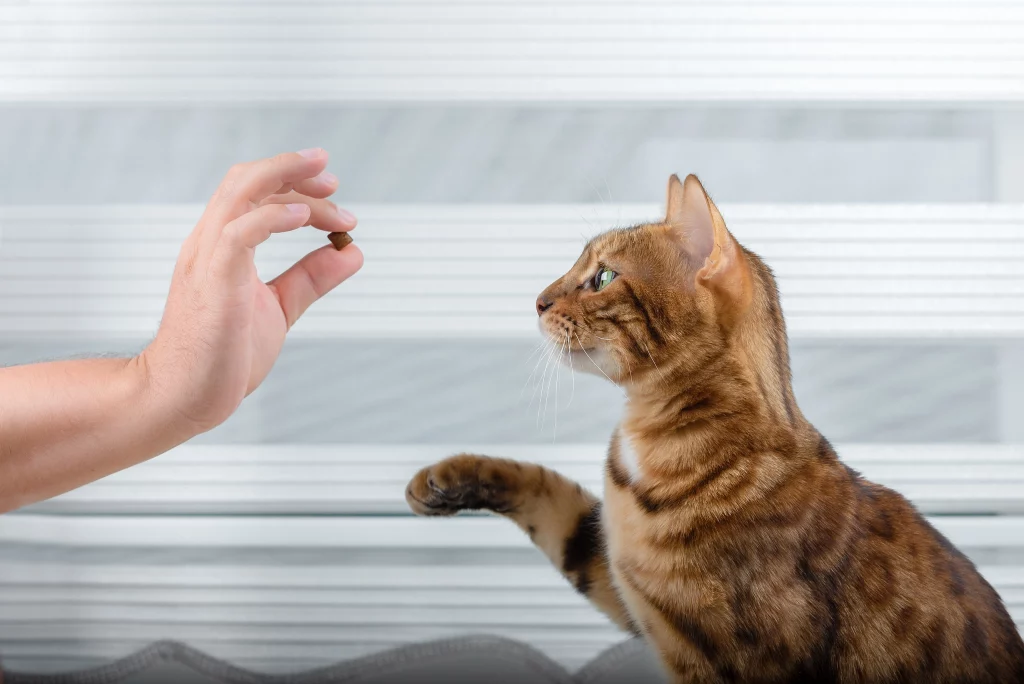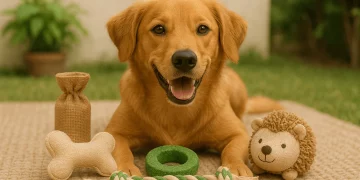Teaching your pet new tricks not only provides entertainment and fun for both you and your pet, but it also plays a crucial role in enhancing their overall well-being. Whether you have a dog, cat, or another pet, learning new tricks can be mentally stimulating, strengthen the bond between you and your pet, and improve communication. In 2024 and 2025, pet owners are exploring new and creative ways to teach their animals tricks, using innovative training techniques and incorporating new tools and methods that maximize success.
In this article, we will explore some of the best tricks to teach your pet, effective training techniques for dogs and cats, and how teaching tricks can improve mental stimulation and create stronger bonds between pets and their owners.
Fun and Useful Tricks to Teach Your Pet
Training your pet to perform tricks is not just for show; many tricks can be useful in daily life, while others serve as a fun way to engage your pet’s mind. Here are some of the most popular and rewarding tricks to teach your pet in 2024-2025:
1. Sit
The “sit” command is one of the most basic and essential tricks you can teach your dog or cat. It serves as the foundation for many other tricks and helps establish good behavior.
How to Teach:
- For Dogs: Hold a treat in your hand and let your dog sniff it. Slowly move the treat over their head towards their back. As their head follows the treat, their bottom will naturally lower. As soon as they sit, say “sit” and reward them with the treat.
- For Cats: Use a treat to lure the cat into a sitting position, rewarding them with positive reinforcement when they do.
Why it’s Useful:
- Helps your pet stay calm in stressful situations.
- Useful in preventing unwanted behaviors, such as jumping on people.
2. Shake Hands/Paw
This classic trick is not only fun but also a great way to reinforce bonding between you and your pet. Many dogs and even cats can learn to offer their paws when asked.
How to Teach:
- For Dogs: Hold a treat in your hand and gently lift one of your dog’s paws while saying “shake” or “paw.” Reward them immediately.
- For Cats: Hold a treat in front of the cat’s paw and lightly touch it to encourage them to lift their paw. Once they do, reward them with the treat.
Why it’s Useful:
- Enhances communication between you and your pet.
- Strengthens the bond by creating a positive experience.
3. Roll Over
Rolling over is a fun and impressive trick that can showcase your pet’s agility and responsiveness. It’s an advanced trick but achievable with patience.
How to Teach:
- For Dogs: Start by getting your dog to lie down. Slowly move a treat around their head to encourage them to roll onto their back, then continue the motion until they roll completely over. Use the command “roll over” and reward them when they complete the action.
- For Cats: This one can be tricky, but some cats can learn by following a treat as it moves in a circle, slowly encouraging them to roll.
Why it’s Useful:
- Promotes flexibility and agility.
- Strengthens the bond as you engage in playful training sessions.
4. Fetch
Fetch is a classic game that most dogs love. It’s not only a great form of exercise but also a wonderful bonding activity.
How to Teach:
- For Dogs: Throw a toy or ball and use a command like “fetch.” Once the dog picks it up, encourage them to bring it back by saying “bring it” or “come” and offering praise when they return it.
- For Cats: You can teach your cat to fetch smaller items by using interactive toys. Start by tossing a ball and encouraging them to bring it back to you. Cats may be less inclined than dogs, but some enjoy the challenge.
Why it’s Useful:
- Provides excellent physical exercise and mental stimulation.
- Strengthens the bond and improves communication.
5. High Five
The “high five” trick is not only entertaining but can be taught relatively quickly.
How to Teach:
- For Dogs: Start by having your dog sit. Hold a treat in your hand and slowly raise it in front of their face, then lift your hand as if you’re giving a high five. When their paw touches your hand, say “high five” and reward them.
- For Cats: Gently tap your cat’s paw and lift it towards your hand. With practice, they’ll start to associate the gesture with the reward.
Why it’s Useful:
- Improves interaction and creates a positive experience between you and your pet.
- Fun and easy trick to show off to others.
6. Stay
Teaching your dog or cat to “stay” is not only useful for training but also ensures your pet’s safety in various situations, like when you open the door or need them to remain in a specific area.
How to Teach:
- For Dogs: Start with your dog in a sitting or lying down position. Hold your hand up and say “stay.” Step back slowly, and if they stay in place, reward them with a treat. Gradually increase the distance and time.
- For Cats: Cats may not stay in place as reliably as dogs, but you can train them to stay in a certain area using treats and a consistent command.
Why it’s Useful:
- Helps with pet safety, especially during outdoor activities.
- Reinforces impulse control and obedience.
7. Play Dead
“Play dead” (also known as “bang” or “playing possum”) is an impressive and theatrical trick that can be a fun challenge for both you and your pet.
How to Teach:
- For Dogs: Start with your dog lying down. Use a treat to lure them to one side while saying the command “bang” or “play dead.” Gently guide them into a position where they stay on their side, and reward them when they remain still.
- For Cats: Cats can be more difficult to train to lie still, but it’s possible with patience. Using positive reinforcement and a favorite treat can help motivate your cat to remain in a “dead” position.
Why it’s Useful:
- Great for showmanship and entertainment.
- Enhances focus and discipline.

The Best Training Techniques for Dogs and Cats
Training your pet to perform tricks successfully requires the right techniques and consistent effort. Here are some of the best methods for training both dogs and cats:
1. Positive Reinforcement
Positive reinforcement is one of the most effective techniques for teaching pets new tricks. This method involves rewarding your pet with treats, praise, or play whenever they perform a desired behavior.
- For Dogs: Use small, tasty treats to reward your dog for performing a trick correctly. Praise them enthusiastically, and always reward them immediately after the trick is performed to help them associate the action with the reward.
- For Cats: Use their favorite treats or toys as rewards. Cats can also respond well to praise, but the key is timing the reward immediately after the trick.
2. Consistency is Key
It’s important to be consistent when teaching your pet a new trick. Always use the same command for the trick and reward them each time they perform the action correctly. Consistency helps your pet understand what’s expected of them.
- For Dogs: Use the same hand gestures and verbal commands to avoid confusion. Practice in short, focused sessions of 10-15 minutes per day.
- For Cats: Cats may have shorter attention spans, so keep training sessions brief but frequent. Use their natural curiosity to help them learn new tricks.
3. Patience and Gradual Progression
Training takes time, and it’s important to be patient. Pets won’t learn a new trick immediately, so avoid becoming frustrated. Break each trick down into smaller steps, and gradually increase the difficulty as your pet masters each stage.
- For Dogs: Start with easy tasks, such as teaching them to sit or shake, before progressing to more complex tricks like roll over or play dead.
- For Cats: Cats can be more independent, so they may not always be as eager to perform tricks. It’s important to let them take breaks if they’re not interested.
4. Timing and Redirection
Timing is crucial when training your pet. It’s important to reward the correct behavior immediately so that your pet understands what they’re being rewarded for. If your pet makes a mistake, calmly redirect them to the correct action instead of using punishment.
- For Dogs: If your dog doesn’t perform the trick correctly, don’t give a treat, but guide them back to the proper position and try again.
- For Cats: If your cat doesn’t perform the trick, try again with patience. Redirect their focus using a toy or treat, and give them time to process the new command.
Benefits of Teaching Tricks for Mental Stimulation and Bonding
Teaching your pet tricks isn’t just about showing off impressive skills—it’s about engaging their minds and building a stronger bond with them.
1. Mental Stimulation
Learning new tricks is a great way to provide mental stimulation for your pet. Both dogs and cats are intelligent animals that benefit from challenges. Regular training sessions help keep their minds sharp, reduce boredom, and prevent destructive behavior.
2. Strengthens the Bond
Training is an opportunity for you to spend quality one-on-one time with your pet. The process of learning and rewarding positive behavior strengthens your bond and fosters a deeper connection. Pets that are trained with positive reinforcement often trust their owners more and feel more secure in their relationship with them.
3. Physical Exercise
Many tricks require physical movement, whether it’s fetching, jumping, or rolling over. These activities can provide much-needed exercise for your pet, especially if they are otherwise sedentary.
Conclusion
Teaching your pet new tricks is a rewarding experience that benefits both you and your furry companion. Whether you’re teaching basic commands like “sit” or more advanced tricks like “play dead,” the training process provides mental stimulation, physical exercise, and strengthens the bond between you and your pet. By using positive reinforcement, patience, and consistency, you can unlock your pet’s full potential and enjoy the satisfaction of a well-trained, happy animal.























































